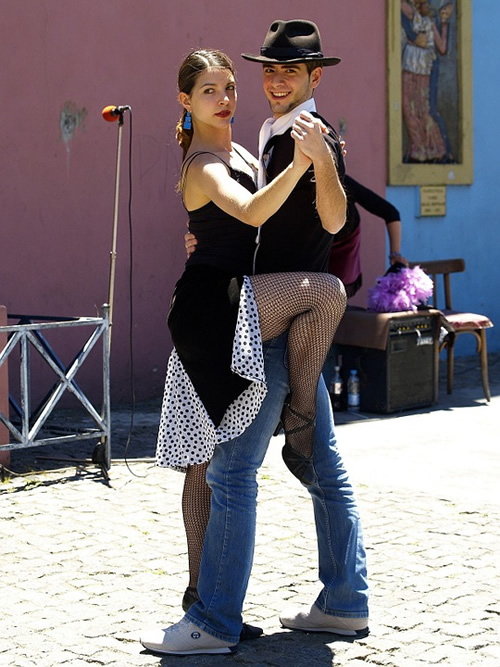Tango Dancing and Love in Argentina
By Andrea Gourgy

|
|
Tango dancing in Buenos Aires is performance art.
|
We were cheek-to-cheek on a Buenos Aires dance floor. My eyes were closed, my arms wrapped tightly around his neck as I followed his every delicate movement almost instinctively. After a 6-week extended stay in Buenos
Aires, it wasn’t until this evening, my very last in the city — until I met Paulo, that is — that I finally understood the tango.
Tango, a dance born of immigrants in the city slums, is now in the air all over the capital. One can even see couples performing expertly in the streets. I had never even heard a tango melody when I decided I would
travel to Buenos Aires to study the 19th century dance. After a 25-hour journey south from Canada, I finally made it to the dance studio where I would spend the bulk of my trip.
Learning at the Tango Dance Studio
Claudia, a world-renowned tango dancer and teacher, sat across from me on a worn couch in her downtown Buenos Aires studio. “First, you must learn the rules of the dance,” she told me as she took a sip
of Mate from a large silver thermos. “First and most importantly,” she continued, “the man must always invite the woman to dance. And the woman should never say no.”
Claudia explained the essential tango protocol: A man makes eye contact with a woman and nods ever so subtly to indicate that he would like to dance with her. The woman then nods in assent. The two get up to meet on
the dance floor.
Argentinean men have very fragile egos according to Claudia. If you turn down even one potential dance partner, no others will risk your rejection.
For a woman, tango is about more than following your partner. It’s about being able to understand his interpretation of the music through non-verbal cues. I knew I was not going to find all I was looking for
in Claudia’s studio, so it didn’t take me long to cut class to head for the milongas. A milonga is a dancing den; it can be held virtually anywhere: a bar, a community center, even outdoors. Drinks are usually served, but the
main event is always the dance.
At first, my nerves caused me to fumble and step on the toes of my unsuspecting partners. They all seemed annoyed. One even abandoned me on the dance floor. Until my last evening, that is.
I was taking in my last bit of tango music and ambiance when a handsome, dark-haired man of about 30 made eye contact and nodded from a distance. I nodded back and we met on the dance floor.
He put his glasses in his back pocket and held me close. We started swaying back and forth to the music, barely moving at all. He alternated the pace, from standing still to performing fast, leg movements. I didn’t
step on his toes once. After a couple of hours, we were sweaty, tired, and drained; but we persisted. I executed movements that Claudia would have never guessed I was ready for. I learned to flick my leg sensually between his legs. I learned
to arch my back and be dipped. I learned to add in my own freestyle embellishments.
I later found out that Paulo was a tango photographer; he spent his time interpreting the dance visually. So I suppose I should not have been surprised that his dancing was so fluent and his interpretation of the music
so smooth. The truth is, all it takes is one good leader to show you what the dance is about. And Paulo did that for me.
For More Info
You can go tango dancing any night of the week in Buenos Aires. Since milongas come and go, your best option is to check out either of the major tango magazines in the city, BA Tango or El Tangauta.
There are many websites dedicated entirely to tango events in Buenos Aires and around the world, and Lonely Planet even has a listing of popular tango locations.
If you’re starting from scratch, you’ll need at least a handful of tango classes before you’ll feel ready to strut your stuff in public.
Safety for Women in Buenos Aires
While Argentina does not have as high a rate of violent crime as some of its South American neighbors, precautions are in order, especially in Buenos Aires.
During the day, buses and the subway (called the “subte” by locals) are perfectly safe. Don’t ever walk alone at night, especially in areas such as La Boca and Retiro. Never take taxis off the street; always
call a Radio-taxi, or even better, take a remise car where a driver will take you to your destination for a fixed rate.
Women travelers will find men in Argentina slightly more subdued than those from other Latin American countries. They are unlikely to squeeze your buttocks or harass you in public; they will, however, hold you tight for a tango
or yell out “mamacita” to you from a car window. Just take it in stride and you’ll be fine.
|
Andrea Gourgy is a freelance writer based in Montreal. She holds a master's degree in print journalism and has worked on three continents.
|
